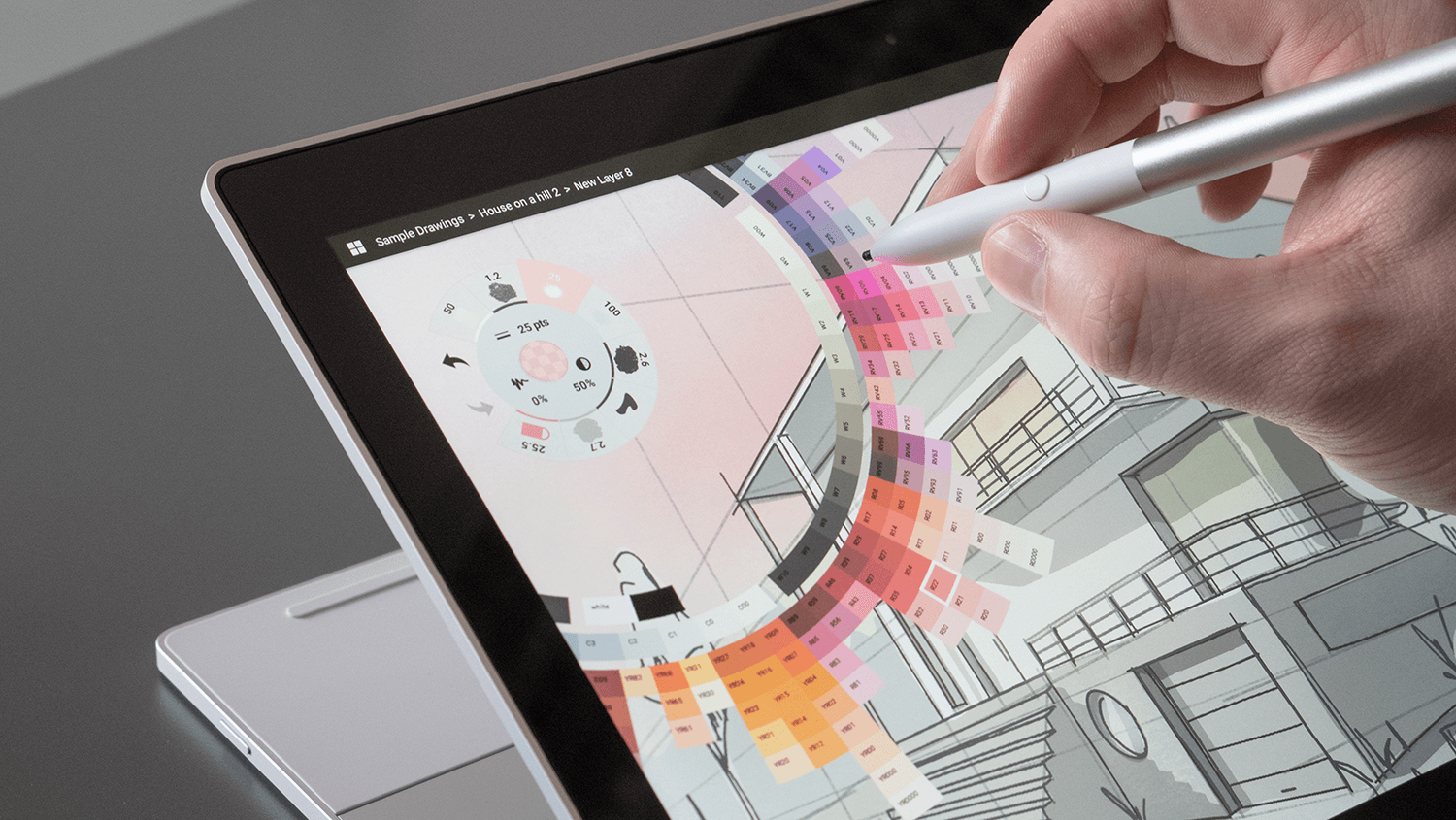![]()
Concepts는 규모는 작지만 탄탄한 결속력을 자랑하는 TopHatch팀이 개발한 앱으로 기존의 스케치북이 가진 유연성에 디지털 그리기 도구의 속도와 활용성을 결합한 고급 디자인 플랫폼입니다. Concepts는 처음부터 모바일의 터치를 활용한 자연스러운 인터페이스를 목표로 개발되었기 때문에 전문 디자이너는 Concepts에서 아름다우면서도 반응 속도가 빠른 도구, 유연한 환경, 조정 가능한 벡터를 사용해 작업할 수 있습니다. 그야말로 창의력을 마음껏 펼칠 수 있는 놀이터라고 할 수 있습니다. TopHatch의 개발자들은 Concepts의 사용자가 자신의 아이디어에 살을 붙일 때 반응 속도 및 정확도가 우수한 스타일러스와 큰 캔버스라는 두 가지 요소를 중시한다는 점을 잘 알고 있었습니다. Pixelbook Pen 및 폴더블 스마트폰과 같은 다용도 기기가 새롭게 떠오르면서 HopHatch팀에서는 Concepts의 UX를 큰 화면과 여러 가지 폼 팩터에 맞게 빌드함으로써 더 많은 크리에이터에게 다가갈 기회를 포착했습니다. TopHatch의 개발자들은 Google이 제공하는 몇 가지 팁과 권장사항에 따라 ChromeOS 및 Android 기기에서 몰입형 환경을 제공하는 Concepts 앱을 빌드하기 시작했습니다.

진행한 작업
고성능 그래픽
이 팀의 최우선 과제는 ChromeOS가 모든 기기에서 Concepts의 날카로운 디자인과 원활한 성능을 지원하는 것이었습니다. Concepts는 뛰어난 최적화를 자랑하는 저레벨 GPU 코드를 실행합니다. 시중에는 매우 다양한 Android 기기가 출시되어 있기 때문에 TopHatch는 모든 드라이버에서 빠른 성능을 제공할 수 있을지 우려했습니다. TopHatch는 Google 엔지니어와 ChromeOS의 기능을 평가한 후 OS의 그래픽이 여러 기기에서 일관되고 호환된다는 사실을 발견했습니다. 즉, 예상보다 훨씬 쉽게 모든 GPU 드라이버에서 최상의 성능을 발휘하도록 앱을 빌드할 수 있었습니다. 개발팀은 최종적으로 렌더링 엔진의 변형을 5개 개발했으며, Android 7 및 OpenGL ES 3.1을 최소 요구사항으로 충족한 후 Concepts는 약 2,500가지 기기에서 멋진 성능을 보여 줄 수 있었습니다. TopHatch는 ChromeOS용 Concepts를 빌드한 후 한 걸음 더 나아가 폴더블 기기에 맞게 앱을 조정했습니다. ChromeOS는 이미 동적 화면 크기 조절을 완벽하게 지원하므로 팀은 반나절 만에 최적화를 완료할 수 있었습니다.
지연 시간이 짧은 스타일러스 및 키보드 지원
빠르고 매끄러운 스타일러스 상호작용은 Concepts에서 제공하는 사용자 환경의 핵심입니다. 디지털 디자이너는 스타일러스를 사용할 때 마치 진짜 펜에서 잉크가 흘러나오는 것 같은 느낌을 받고 싶어 합니다. TopHatch의 다음 목표는 이를 위해 터치 입력을 수신한 다음 화면에 스트로크를 렌더링하기까지의 지연을 가능한 한 최소한으로 줄이는 것이었습니다.
TopHatch에서는 Android와 Chrome OS 사이의 모든 소프트웨어 레이어에서 지연 및 '찢어짐'과 같은 부작용이 나타날 가능성이 높음을 알고 있었습니다. '찢어짐'이란 스트로크가 화면에서 부분적으로 표시되거나 잘못 표시되는 현상을 말합니다. 팀에서는 프런트 버퍼 렌더링에서 답을 찾았습니다. Chrome OS의 보안성과 단순성을 기반으로 삼는 프런트 버퍼 렌더링은 그리기 과정에서 소프트웨어 레이어를 우회하여 픽셀이 최소한의 횟수로 복사되도록 도왔습니다. 따라서 스타일러스 입력이 감지되었을 때 지연이 발생할 가능성이 크게 줄어들기 때문에 Concepts는 실제 펜을 사용해 종이에 그림을 그리는 듯한 느낌을 줄 수 있었습니다. 또한 TopHatch는 Concepts의 프로젝트 탐색 및 툴바 화면에서 직관적인 키보드 지원을 구현하기로 결정했으며 이를 통해 디자이너들은 앱에서 그림을 그리고 있지 않을 때도 더욱 간편하게 프로젝트를 관리하고, 이름을 변경하고, 확인하고, 공유할 수 있습니다.
결과
ChromeOS에서 Concepts를 사용해 본 디자이너들은 뜨거운 반응을 보였습니다. 평균적인 Concepts 사용자는 다른 기기에 비해 Chromebook에서는 12배 더 많은 시간을, Google Pixelbook과 Pixel Slate에서는 20배 더 많은 시간을 보냅니다. 또한 TopHatch는 Chromebook 사용자가 유료 사용자로 전환하는 비율이 다른 기기 대비 Pixelbook에서는 2배, Slate에서는 4배 더 높다는 사실도 확인했습니다. TopHatch의 공동 창립자 겸 CEO인 데이빗 브리튼은 "ChromeOS용 앱을 빌드한 덕분에 참여도가 높은 잠재고객에게 도달할 수 있었고 대규모 Android 시장을 확보할 수 있었습니다."라고 말했습니다. 저희는 큰 화면에 적합한 디자인을 통해 사용자층을 늘릴 수 있다는 사실을 알고 있었으며, 이미 매우 긍정적인 사용자 의견을 받았습니다."라고 말합니다. TopHatch는 매달 제공되는 업데이트를 통해 사용자를 지원하기 위해 최선을 다하고 있으며, 최근에는 많은 사용자가 요청한 바 있는 이미지 가져오기 기능도 선보였습니다. 디자이너들은 이 기능을 사용해 자신의 사진 위에 스케치나 표시를 할 수 있습니다. 팀은 ChromeOS 및 Android에서 크리에이터와 협업하고 모든 스트라이프의 디자이너가 강력하면서도 창의적인 모바일 라이프스타일을 구현할 수 있기를 기대합니다.
시작하기
ChromeOS에 맞게 앱을 최적화하는 가장 좋은 방법을 알아보세요.

